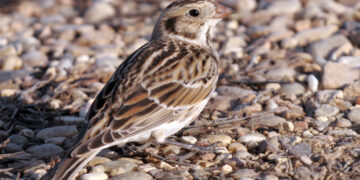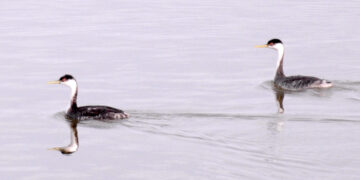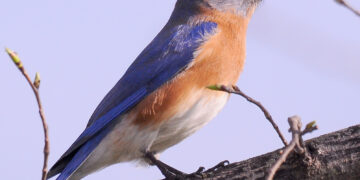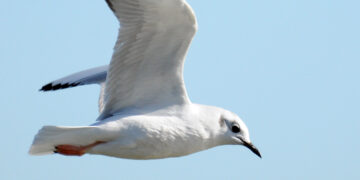The rainbow bird
This week’s featured creature is one of the most — if not the most — beautiful birds in the United States.
I realize beauty is in the eye of the beholder, but the painted bunting is certainly a spectacularly colored songbird, to say the least. And it’s a bird that not everyone in this great country gets to enjoy.
The male painted bunting is certainly striking. It has a blue head with a red circle around its eyes. Its neck, breast and belly are red to orange-red. It has a light green back with a red rump and its tail and wings can be a mixture of any or all of its colors.
I will say this little bird does look like an artist took a paintbrush to it with spectacular reds, blues and greens.
Additionally, its colors are metallic, especially when the sun shines on the feathers.
Female painted buntings also have feathers that have a sheen in the sunlight, however, they are not as colorful as males and are green above and yellowish below.
And even though the painted bunting is relatively common in this area, it is not uncommon to rarely have seen them. You would think that a bird as colorful as the painted bunting would stick out like a sore thumb, but it is hard to see its colors from a distance. They are not easily identifiable, nor are they easily photographed.
The painted bunting is a neotropical migrant. It breeds and spends summers in the U.S. and a portion of northern Mexico, but winters further south of us.
Sadly, the painted bunting is a popular caged bird in certain parts of the world. It was once a popular pet here, but it is now illegal to capture one — or own one — in the United States. However, the birds are not so protected in the countries where they winter. And their population is declining.
The University of Oklahoma released information a few years back that a bird nerd like me finds fascinating.
Andrea Contina, an OU researcher who is also a National Science Foundation, National Research Traineeship postdoctoral fellow, and his team recently identified the genetic structure of the painted bunting.
According to OU, the team used microsatellite DNA and single nucleotide polymorphisms to develop high-resolution markers to differentiate between individual birds breeding in different Oklahoma populations and across the country.
I thought my head was going to explode the first time I read that.
But what that breakthrough research means is that Contina and his team now can differentiate between the eastern and western painted buntings (there is a population in our area and another in the eastern U.S., but more on that later) and identify the species pattern of migration and population of origin.
“We combine molecular genetic research and conservation biology to differentiate between Painted Bunting populations and individual birds that migrate across several countries for breeding in the United States during the summer, then migrate to Central America for wintering where often they are captured and sold in the international avian pet market,” Contina said. “Genetic markers allow us to differentiate where the birds come from after they are sold.”
Because the males are so beautiful and brightly colored, they are highly sought after as pets, particularly in Mexico, Central America and Europe.
According to OU, pet market birds examined in the published study are most likely from the central breeding population in the U.S. One bird can sell for as much as $800 in the international avian pet market.
Range
I mentioned previously how not everyone in the country can see this bird where they live as the bird occupies only about 10 or so states. I believe their largest breeding populations must be in Texas and Oklahoma. The painted bunting’s breeding range includes nearly all of Texas; most of Oklahoma, all but the Panhandle; most of eastern Kansas; the southwest fourth of Missouri; all of Arkansas; the western half of Mississippi; and all of Louisiana. There is also a breeding population that encompasses the southeastern half of South Carolina, southeastern Georgia and a portion of northeast Florida.
Painted buntings winter in southern Mexico, Central America, the Caribbean and the southern half of Florida.
Diet
Painted buntings eat seeds, and, during the breeding season, eat a lot of insects. I know white proso millet is a favorite at summer bird feeders.
According to the Cornell Lab of Ornithology, painted buntings are more likely to eat seeds after the breeding season is over, starting in midsummer. Also, they’re more likely to visit a bird feeder in a yard with low, dense vegetation.
During the breeding season they catch grasshoppers, weevils and other beetles, caterpillars, bugs, spiders, snails, wasps and flies.
They forage on the ground for seeds of bristle grass, pigweed, wood sorrel, spurge, panic grass, St. John’s wort, sedge, dock, pine, rose, wheat, or fig, the CLO reports.
Habitat
Painted buntings like semi-open areas best. Like a field that hasn’t been brush-hogged in a few years. They also like woodland edges, roadsides, brush, towns and gardens. According to the National Audubon Society, painted buntings breed around thickets, hedgerows, woodland clearings and edges and undergrowth of open woods.
Nesting
According to the CLO, the male and female search for a place in dense vegetation for a nesting site. Once chosen, the female then constructs the nest.
She will lay three to four eggs and incubate them for about 12 days. Nestlings fledge quickly at about 10 days.
A pair of painted buntings will raise one to three broods per year.
Odds and ends
Although a small songbird — about five inches in length — painted buntings can be quite savage when defending their territory. Males will sometimes fight to the death!
According to the National Audubon Society, males will peck, grapple, and strike each other with their wings. Their fights end with lost feathers, wounds and eye damage. Though severely territorial during the breeding season, painted buntings may form small flocks on the wintering grounds, often joining other seed-eating species.
Painted buntings produce wonderful songs and even calls. They warble a series of high-pitched musical notes while singing, often from treetops. I love hearing them every spring when they return to the area.
Editor’s Note: Randy Mitchell is a freelance writer and photographer. He has been an avid birdwatcher, nature enthusiast and photographer for more than 40 years. Reach him at [email protected].
Want to reach a local audience and grow your business?
Our website is the perfect platform to connect with engaged readers in your local area.
Whether you're looking for banner ads, sponsored content, or custom promotions, we can tailor a package to meet your needs.
Contact us today to learn more about advertising opportunities!
CONTACT US NOW







